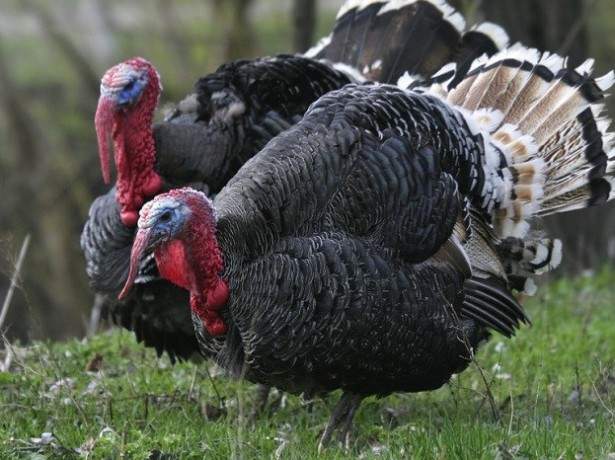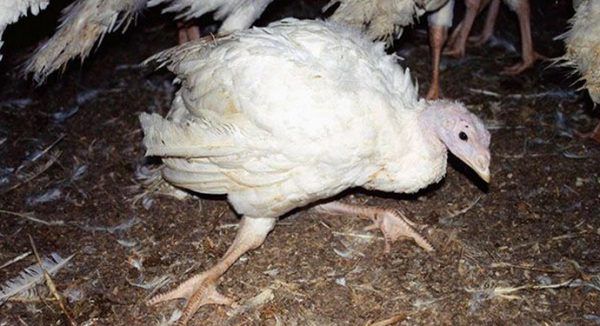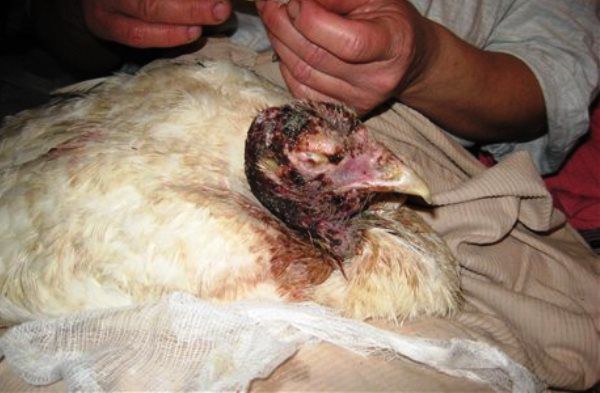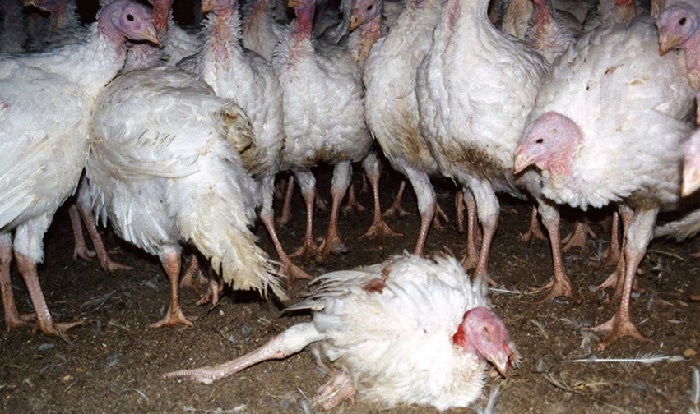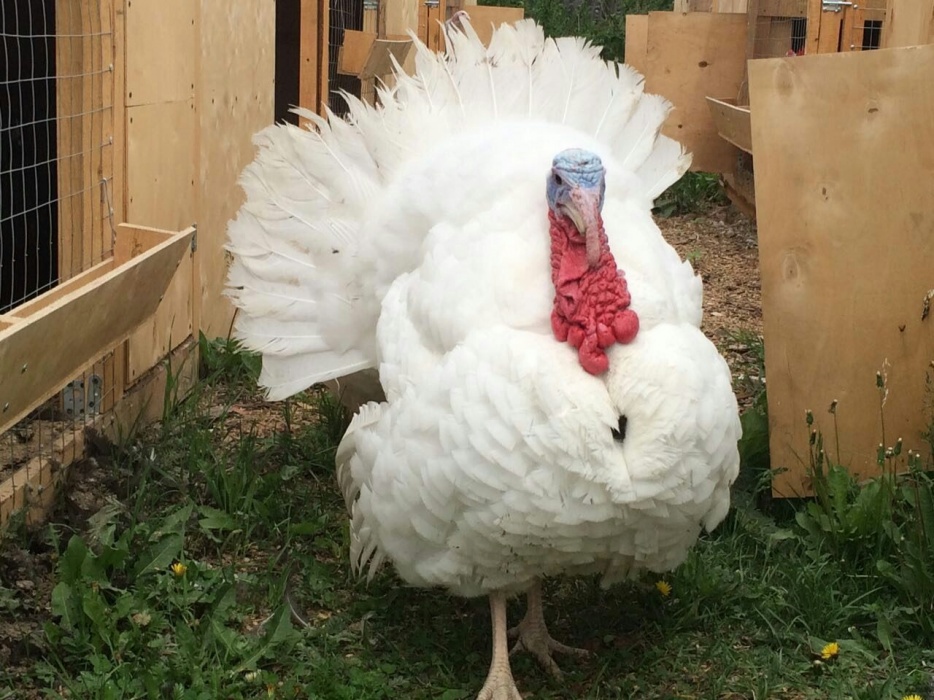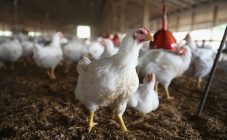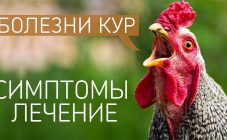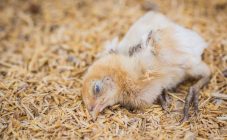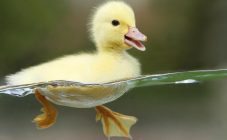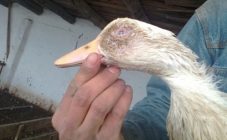Content:
Turkeys are large, beautiful birds that were brought to Europe from America over a thousand years ago. Of all poultry, turkeys have the greatest return on tender and dietary meat. The main disadvantage of growing is turkey diseases, especially turkey diseases. Before breeding a meat breed of poultry, it is necessary to study what kind of disease turkey poults suffer, what is their symptom and method of treatment.
Signs of a weak individual
Small turkeys are very sensitive to conditions of detention, nutrition, air temperature. Until they grow up and get stronger, they are susceptible to many bird diseases.
Sick birds show the following symptoms:
- gait - wobbly, shaking legs;
- eyes - dull, dull, sunken;
- feathers - disheveled, stuck together, do not shine;
- the wings are spread apart, raised, and the corners are lowered;
- hides, avoids the general flock;
- general condition - sluggish, sedentary, stands in one place for a long time, constantly falls.
To prevent the rest of the chicks from getting sick, sick individuals are placed in a separate room and a veterinarian is called to diagnose the turkey poults.
Non-infectious diseases of turkeys
Before you start raising turkeys, you need to study what diseases turkeys get sick and how to treat them at home.
Diseases and treatments
| Name of the disease | Causes | Symptoms | Treatment |
|---|---|---|---|
| Hypovitaminosis | Lack of vitamins and minerals | Lachrymation, underdeveloped growth, inflammation of the cloaca, diarrhea | Prescribe a complex of vitamins, drugs "Chiktonik" and "Trivit" |
| Rickets | Lack of vitamin D | The joint, bones are deformed, the bird has weak legs and body, perosis develops | Treat with "tricalcium phosphate", fish oil, vitamin D |
| Hard goiter and sagging severe goiter | An excess of roughage, a lack of shell rock and gravel, poor nutrition | Clogged, grain-clogged goiter. Purulent discharge from goiter. The turkey is passive | It is removed surgically, for prevention - feed with high-quality compound feed, do not overfeed |
| Pica | Lack of trace elements in the feed | The bird bites everything: stones, bedding, sawdust, feathers | Change the diet, give more fortified feed |
Frequent illnesses
Of the non-communicable diseases, young animals are most often affected by vitamin deficiency, which manifests itself with a lack of vitamins and minerals in the diet. Against this background, rickets, lacrimation, runny nose, and weakness develop. The chick may swell or faint. Disease is eliminated with vitamin injections and a more varied diet.
Enteritis
A kind of dysentery.
In a sick turkey:
- loss of appetite;
- diarrhea with undigested food particles;
- weakness, passivity.
The source of the disease is dirty, moldy, poor-quality food. The chick's intestines are affected, he feels pain when swallowing.
Sick turkey poults are quarantined and treated with antibiotics. After recovery, the chicks are returned to the flock.
Cannibalism
With a lack of protein in the feed, the birds begin to eat each other. If aggressive behavior towards fellows is noticed behind the chick, it should be immediately removed from the rest. At the same time, the wings and beak are cut off.
Infectious diseases and their manifestations
These are the most dangerous diseases, they are easily transmitted from one individual to another, which is why a turkey often dies at 2 months.
If the bird begins to itch, it has fleas, these are carriers of infection. It is necessary to be attentive to the behavior and appearance of turkeys, to pay attention to such phenomena as lethargy and refusal to eat. These are the first signs of infection of the chick and the harbingers of diarrhea.
The cause of the disease is determined by the color of the stool:
- brown with particles of undigested food - poor quality feed, not enough mash;
- yellow - intestinal infection with pathogenic microflora;
- green - an advanced form of a viral disease;
- white - dangerous, indicates the development of pullorosis.
Description of common infections
| Name of the disease | Cause | Symptoms | Treatment |
|---|---|---|---|
| Tuberculosis | Infection through inventory, food, water, air | Dramatic weight loss, lameness, white lesions on the skin | It is not subject to treatment, sick birds are disposed of, the premises and equipment are disinfected |
| Worms (histomoniasis) | The worm enters the intestines through dirty water, inventory, earth, earthworms, arthropods | Drowsiness, green diarrhea, low body temperature, the skin on the head turns blue | Phenothiazine, histamon, amprolium. |
| The room is disinfected, the ground is covered with lime | |||
| Smallpox | Disease vectors - mosquitoes, insects | Photophobia, passivity, spread wings, yellow spots on the neck and head, ulcers on the mucous membranes | With diphtheria form of smallpox - birds are burned, with skin - treated with vitamins of group A and ampicillin injections |
| Synovitis | Lack of vitamins and overcrowding of birds | Apathy, immobility, lameness | Biomycin, streptomycin, terramycin |
If the bird is sick with Newcastle disease, the turkey develops diarrhea, the goiter becomes inflamed. Paralysis of the limbs and death soon follow. Treatment does not give positive results. To prevent the development of the disease, turkey poults are vaccinated.
Carriers of the disease - arthropods, rats, birds, the disease is easily transmitted through:
- feathers;
- litter;
- feed;
- inventory;
- by airborne droplets.
The Newcastle symptom resembles the manifestations of influenza, conjunctivitis develops, mucus appears in the nose, and a green liquid flows from the cloaca.
Sick chicks with an acute stage of pseudo-plague are disposed of and disinfected in the poultry house. The disease is serious - it has the highest mortality rate.
Young stock infections
Each disease has its causes and distinctive features:
- aspergillosis - the respiratory tract is affected by a fungus;
- trichomoniasis - affects the intestines and liver;
- paratyphoid - the infection affects young individuals from birth to one month of age;
- pasteurellosis - the infection is in the nature of an epidemic, massively affects young animals;
- coccidosis - intestinal lesions with bloody diarrhea.
Histomoniasis
At two weeks of age, the chick inflames the cecum, and the liver is disrupted, the head and neck turn black. The disease is caused by helminthic invasions. They are treated with trichopolum, furozalidone.
Pullorosis
There are 2 types of treatable pullorosis in chicks:
- congenital - chicks are born already sick;
- postnatal - they get infected from sick individuals.
The characteristic signs of the disease are discharge of white mucus from the cloaca. Turkey poults weaken, stand for a long time with closed eyes, while the beak is open.
The consequences of the disease and how the turkey is treated:
- stunting, poor development;
- rare plumage;
- sore joints.
It is treated with antibacterial drugs, in advanced cases the bird dies.
Mycoplasmosis
At the age of one month, runny nose, cough of turkey poults are dangerous. They begin to breathe heavily, wheeze, white snot appears in the beak, respiratory sinusitis develops - mycoplasmosis. In a more complex form of the disease, the chick's head may swell, it is difficult for him to breathe, he becomes completely helpless.
Bird head disease develops in the cold season, when the immunity of birds is weakened, and the question arises: if a turkey sneezes, how is it treated.
If sinusitis occurs in turkeys, treatment can be done independently.
How to treat sinusitis in turkey poults
Initially, the sinuses are cleared of pus, then antibiotics are injected into them every day:
- oxytetracycline;
- furozalidone;
- streptomycin.
At the same time, for a week, the bird is watered with Tylosin 200 solution.
After the main antibiotic treatment, the chick is watered with Farmazin's solution for 2 weeks.
The large breed of turkeys, the Big 6 cross, is very popular among poultry houses.
Turkeys will not be able to gain weight if disease prevention is not carried out from the first birthday:
- 1 week given antibiotics;
- 2nd week - vitamin D;
- 3rd week - nystatin, trichopolum, metronidazole;
- give a full vitamin complex according to the scheme.
Disease prevention
The poultry house must provide:
- fresh air and good ventilation;
- a lot of sunlight;
- lack of drafts;
- clean, dry bedding;
- clean water in drinking bowls and quality feed in clean troughs.
In the room, carry out disinfection measures, process inventory, walls, ceilings.
Monitor the condition of chicks, sick and weak, quarantine.
Vaccine young animals on time. Prevent rats, insects and ticks from breeding in the house.
Prevention is based precisely on the observance of hygiene and balanced nutrition of turkeys. If these requirements are met, turkey poults can be extended life, the birds will grow up healthy and strong.
